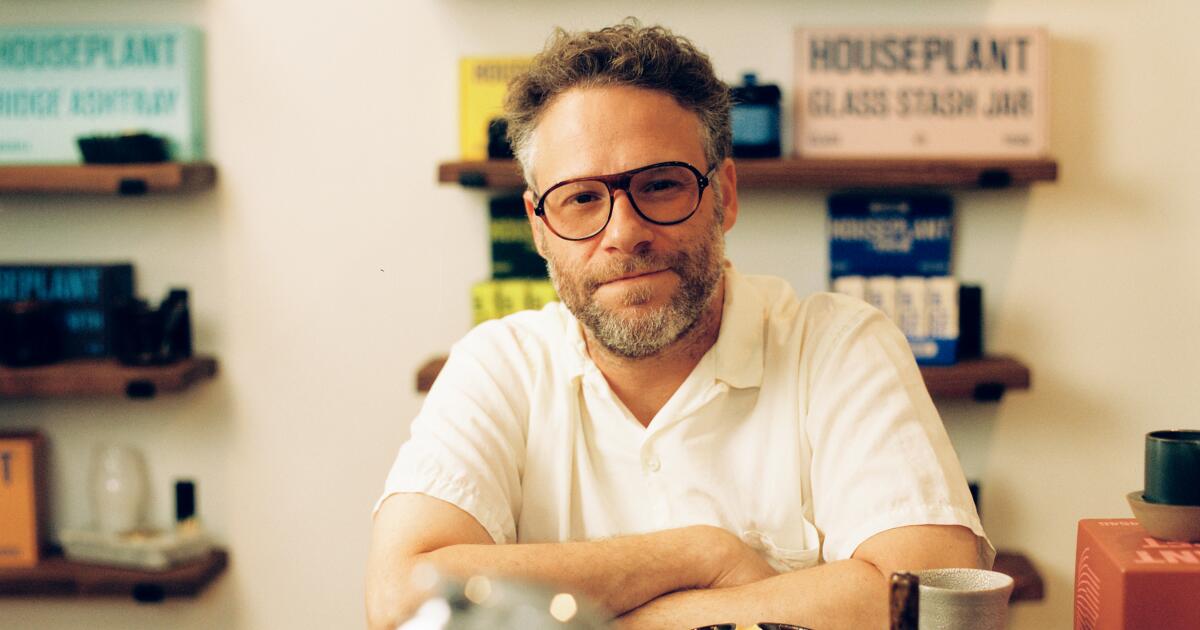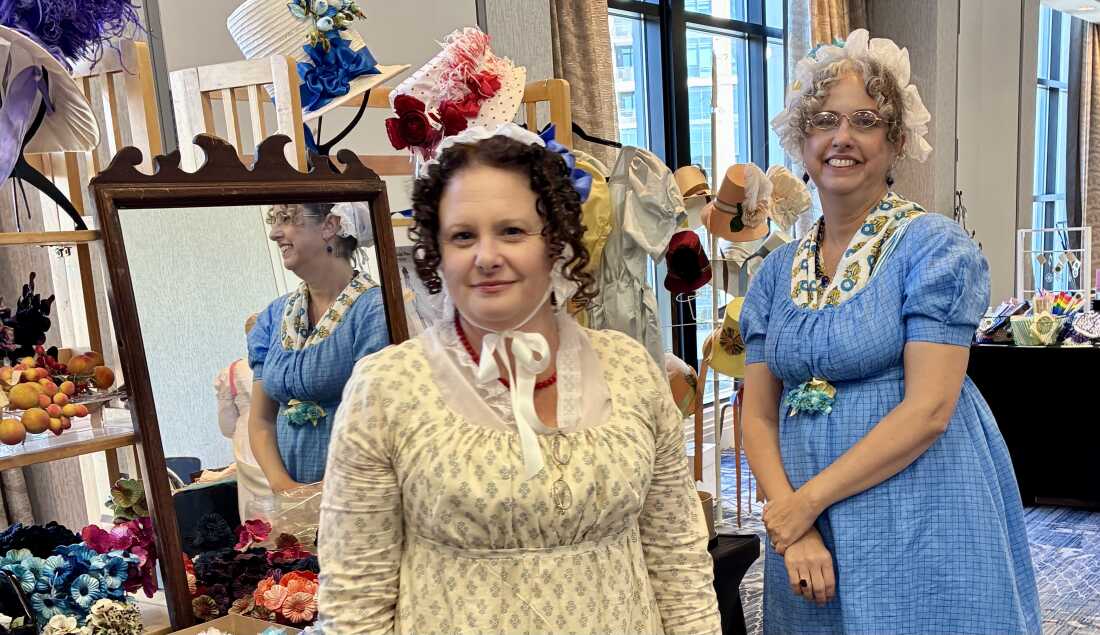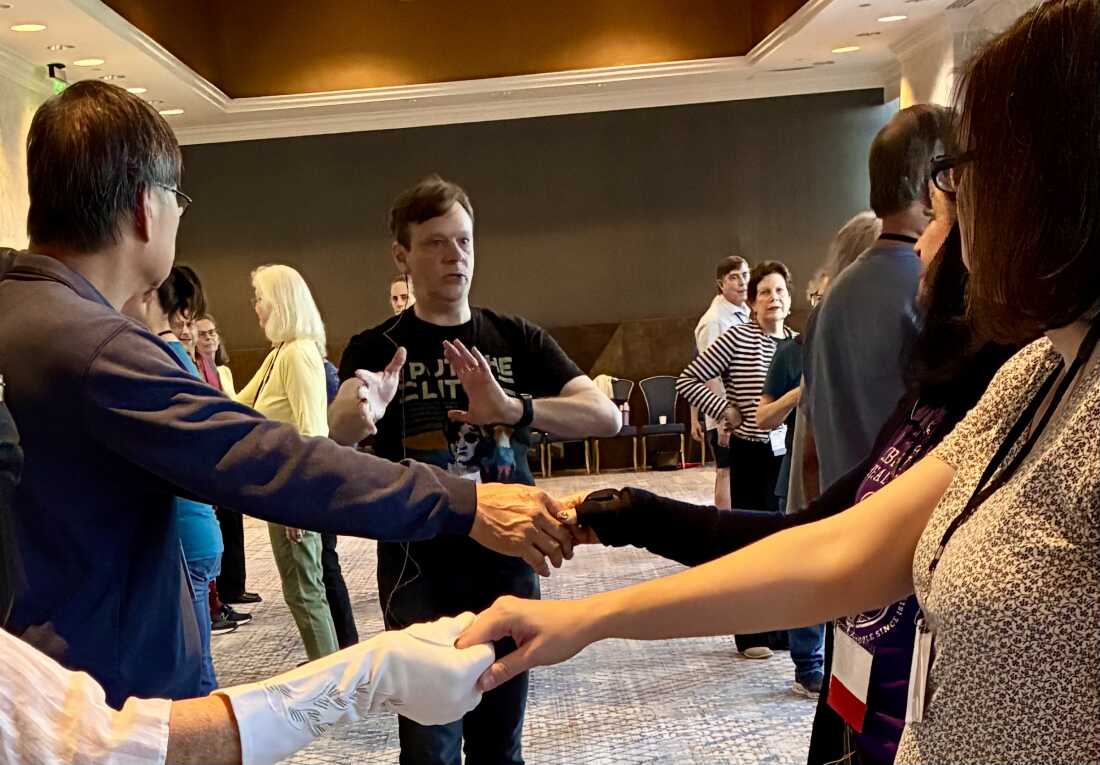Lifestyle
Seth Rogen has a 567-piece vintage ashtray collection. It started with a hedgehog

If your perception of Seth Rogen begins and ends with his scruffy stoner/schlubby Everyman persona, you might be surprised to find out that the actor, producer, comedian and cannabis-brand entrepreneur is also an ashtray aesthete of the highest caliber and owner of a massive, museum-worthy collection of seriously stylish ashtrays from days gone by.
Seth Rogen and some favorite ashtrays from his extensive collection.
Rogen’s collection was amassed over the last two and a half decades and is heavy on colorful Midcentury Modern ashtrays. He thinks his approximately 567 pieces might possibly be the world’s largest collection of vintage ashtrays. (The arbiter of such things — the Guinness Book of Records — doesn’t distinguish between vintage or nonvintage in recognizing an Australian man’s 1,560 pieces as the world’s largest ashtray collection.) But even without that superlative, it’s an impressive collection, comprised of pieces from the Golden Age of ashtrays, the period from the 1920s through the late 1970s during which exceptional craftsmanship was focused on what’s essentially a miniature fireproof trash can.
Although most of Rogen’s collection has been meticulously cataloged and placed in storage, a few dozen pieces, including lantern-like ceramic ashtrays designed to hang from tree branches and stackable mini-ashtray sets in a rainbow of colors, are on display at the Hollywood offices of Houseplant, the cannabis and housewares brand launched by Rogen and longtime friend Evan Goldberg in 2021. At those offices is where, a few years back, I first became aware of the massive cache of ash catchers.
And it’s at that cottage-style space, part showroom and part Midcentury Modern VIP party pad, with a turntable near the fireplace and Houseplant accouterments and ashtrays dotting every available surface, that Rogen met me on a recent summer afternoon to highlight a handful of his favorite pieces and talk about how to share the collection more widely with the world. (An interactive ashtray exhibition, anyone?)

The Walter Bosse stacking hedgehog ashtray, stacked …

… and unstacked.

Lifestyle
Remembering Rob Reiner, who made movies for people who love them

Rob Reiner at his office in Beverly Hills, Calif., in July 1998.
Reed Saxon/AP
hide caption
toggle caption
Reed Saxon/AP
Maybe an appreciation of Rob Reiner as a director should start with When Harry Met Sally…, which helped lay the foundation for a romantic comedy boom that lasted for at least 15 years. Wait — no, it should start with Stand By Me, a coming-of-age story that captured a painfully brief moment in the lives of kids. It could start with This Is Spinal Tap, one of the first popular mockumentaries, which has influenced film and television ever since. Or, since awards are important, maybe it should start with Misery, which made Kathy Bates famous and won her an Oscar. How about The American President, which was the proto-West Wing, very much the source material for a TV show that later won 26 Emmys?


On the other hand, maybe in the end, it’s all about catchphrases, so maybe it should be A Few Good Men because of “You can’t handle the truth!” or The Princess Bride because of “My name is Inigo Montoya, you killed my father, prepare to die.” Maybe it’s as simple as that: What, of the words you helped bring them, will people pass back and forth to each other like they’re showing off trading cards when they hear you’re gone?
There is plenty to praise about Reiner’s work within the four corners of the screen. He had a tremendous touch with comic timing, so that every punchline got maximum punch. He had a splendid sense of atmosphere, as with the cozy, autumnal New York of When Harry Met Sally…, and the fairytale castles of The Princess Bride. He could direct what was absurdist and silly, like Spinal Tap. He could direct what was grand and thundering, like A Few Good Men. He could direct what was chatty and genial, like Michael Douglas’ staff in The American President discussing whether or not he could get out of the presidential limo to spontaneously buy a woman flowers.
But to fully appreciate what Rob Reiner made in his career, you have to look outside the films themselves and respect the attachments so many people have to them. These were not just popular movies and they weren’t just good movies; these were an awful lot of people’s favorite movies. They were movies people attached to their personalities like patches on a jacket, giving them something to talk about with strangers and something to obsess over with friends. And he didn’t just do this once; he did it repeatedly.
Quotability is often treated as separate from artfulness, but creating an indelible scene people attach themselves to instantly is just another way the filmmakers’ humanity resonates with the audience’s. Mike Schur said something once about running Parks and Recreation that I think about a lot. Talking about one particularly silly scene, he said it didn’t really justify its place in the final version, except that everybody loved it: And if everybody loves it, you leave it in. I would suspect that Rob Reiner was also a fan of leaving something in if everybody loved it. That kind of respect for what people like and what they laugh at is how you get to be that kind of director.
The relationships people have with scenes from Rob Reiner movies are not easy to create. You can market the heck out of a movie, you can pull all the levers you have, and you can capitalize on every advantage you can come up with. But you can’t make anybody absorb “baby fishmouth” or “as you wish”; you can’t make anybody say “these go to 11” every time they see the number 11 anywhere. You can’t buy that for any amount of money. It’s magical how much you can’t; it’s kind of beautiful how much you can’t. Box office and streaming numbers might be phony or manipulated or fleeting, but when the thing hits, people attach to it or they don’t.
My own example is The Sure Thing, Reiner’s goodhearted 1985 road trip romantic comedy, essentially an updated It Happened One Night starring John Cusack and Daphne Zuniga. It follows a mismatched pair of college students headed for California: She wants to reunite with her dullard boyfriend, while he wants to hook up with a blonde he has been assured by his dirtbag friend (played by a young, very much hair-having Anthony Edwards!) is a “sure thing.” But of course, the two of them are forced to spend all this time together, and … well, you can imagine.
This movie knocked me over when I was 14, because I hadn’t spent much time with romantic comedies yet, and it was like finding precisely the kind of song you will want to listen to forever, and so it became special to me. I studied it, really, I got to know what I liked about it, and I looked for that particular hit of sharp sweetness again and again. In fact, if forced to identify a single legacy for Rob Reiner, I might argue that he’s one of the great American directors of romance, and his films call to the genre’s long history in so many ways, often outside the story and the dialogue. (One of the best subtle jokes in all of romantic comedy is in The American President, when President Andrew Shepherd, played by Michael Douglas, dances with Sydney Wade, played by Annette Bening, to “I Have Dreamed,” a very pretty song from the musical … The King and I. That’s what you get for knowing your famous love stories.)
Rob Reiner’s work as a director, especially in those early films, wasn’t just good to watch. It was good to love, and to talk about and remember. Good to quote from and good to put on your lists of desert island movies and comfort watches. And it will continue to be those things.

Lifestyle
‘This feels like home.’ A fashionably late night out to the Pico Rivera Sports Arena

This story is part of Image’s December Revelry issue, honoring what music does so well: giving people a sense of permission to unapologetically be themselves.
The belt used to belong to his father. Black leather, silver stitching, “RUBEN” spelled across the side with the initials “R.V.” on the buckle, for Ruben Vallejo, a name both men share. Now it sits on the waist of the younger Vallejo as he gets ready for a night out at the Pico Rivera Sports Arena, a place he’s been to “over 50 times,” he says, but this one’s special. He tucks in his thrifted button-up shirt, adjusts his belt buckle and looks in the mirror.
For the Vallejo family, the arena is a second home and dancing there is tradition. It stands as a cultural landmark for Los Angeles’ Mexican community, hosting decades of concerts, rodeos and community celebrations. Vallejo’s parents first started going in the early ’90s, when banda and corridos began echoing across L.A. Tonight, the beloved crooner Pancho Barraza is performing and Vallejo is going with his mom, sister, aunt and godmother.

Vallejo wears a black tejana from Marquez Clásico, a thrifted vaquero-style button up, thrifted jeans and a belt passed down from his father.
At 22, Vallejo doesn’t see música regional Mexicana as nostalgia — it’s simply who he is, something he wears, dances to and claims as his own. “I want to revive this and let other people know that this art and culture is still alive,” says Vallejo. “From the way that I dress, from the music I listen to, I want to let everybody know that the kids like this.”
It’s a little past 6:30 p.m. on a Sunday in late October, and the sound of a live banda carries from a small Mexican restaurant near the Vallejo family’s Mid-City home as the excitement for the night builds. The horns and tambora spill into the street as the neighborhood celebrates early Día de los Muertos festivities. Inside, Vallejo opens the door to his storybook bungalow, where his parents lounge in the living room. But it’s his bedroom that tells you who he is — a space that feels like a paisa museum.
Thrifted banda puffer jackets hang on the closet wall: Banda Recodo, Banda Machos, El Coyote y su Banda Tierra Santa. Stacks of CDs and cassette tapes line his dresser, from Banda El Limón to Banda Móvil and a signed Pepe Aguilar. On one wall, a small black-and-white watercolor of Chalino Sánchez he painted himself hangs beside a framed Mexico 1998 World Cup jersey. “Everything started with my grandpa,” Vallejo says. “He was a trombone player and played in a banda in my mom’s hometown in Jalisco.”




Music runs in the family. His uncles started a group called Banda La Movida, and Vallejo is still teaching himself acoustic guitar when he’s not apprenticing as a hat maker at Márquez Clásico, crafting tejanas and sombreros de charro.
“I feel like being an old soul gives people a sense of how things used to be back in the day,” he says of the intergenerational bridge between his work and personal interests. “That connection is something so needed right now.”
Beyond the banda memorabilia, the real story lives in the old family photos — snapshots of backyard parties, his parents in full ’90s vaquero style in L.A. parking lots and a large framed portrait of his uncles from Banda La Movida, posing in matching blue jackets and white tejanas.
“This is a picture of us in the [Pico Rivera Sports Arena] parking lot. We’d go to support my cousins in a battle of the bandas. Which also meant fan clubs against fan clubs. The pants were a lot more baggy then,” explains Vallejo’s mother, Maria Aracely, in Spanish.



The belt used to belong to his father. Black leather, silver stitching, “RUBEN” spelled across the side with the initials “R.V.” on the buckle, for Ruben Vallejo, a name both men share.
Vallejo’s look for the night is simple but intentional: a black tejana from Márquez Clásico, a thrifted black-and-white vaquero-style button-up patterned with deer silhouettes, loose “pantalones de elefante,” as he calls them, his dad’s brown snakeskin boots, and, of course, the embroidered belt that ties it all together.
“This is very Pancho Barraza-style, especially with the venado shirt. I looked up old videos of him performing on YouTube. I do that a lot with these older banda looks,” Vallejo says.
A rustic leather embroidered bandana with “Banda La Movida” stitched vertically hangs from his left pocket — a keepsake his mom held onto from her brothers’ group back in the day.

“I feel like being an old soul gives people a sense of how things used to be back in the day. That connection is something so needed right now.”
Running fashionably late, Vallejo arrives at Barraza’s concert with less than an hour to spare, but he seems unbothered. His mom and older sister, Jennifer, are there, along with his aunt and godmother. A mix of mud and alcohol hangs in the air as the family makes their way across the fake grass tarps covering the lower level of the arena. Barraza is onstage with a mariachi accompanying his banda. With the amount of people still out drinking and dancing, it’s hard to believe it’s past 10 o’clock on a Sunday night.
Walking past the stands, Vallejo’s mother is in awe as she points out a certain upper level section of the arena and recalls the amount of times she would sit there and see countless bandas before she had Ruben and his sister. As the concert nears the end, Barraza closes with one of Vallejo’s favorite songs, “Mi Enemigo El Amor,” which Vallejo belts out, jokingly heartbroken.
“I hadn’t seen him live yet and the ambiente here feels great because everyone here is connected to the music. Even though we’re in L.A. this feels like home, like Mexico.”
Frank X. Rojas is a Los Angeles native who writes about culture, style and the people shaping his city. His stories live in the quiet details that define L.A.
Photography assistant Jonathan Chacón

Lifestyle
All about character: Jane Austen fans on their favorites

Jane Austen ready to party for her 250th birthday at the Jane Austen Society of North America’s Annual General Meeting in Baltimore.
Melissa Gray/NPR
hide caption
toggle caption
Melissa Gray/NPR
In her six completed novels, Jane Austen excelled at love stories: Elinor and Edward, Lizzie and Darcy, Fanny and Edmund, Emma and Knightley, Anne and Wentworth, heck even Catherine and Tilney. As her fans celebrate the 250th anniversary of her birth, they’d like you to know it’s a mistake to simply dismiss her work as light, frothy romances. It’s full of intricate plots, class satire and biting wit, along with all the timeless drama of human foibles, frailties and resolve.

Tessa Harings (left) learns English country dance at the Jane Austen Society of North America’s 2025 Annual General Meeting
Melissa Gray/NPR
hide caption
toggle caption
Melissa Gray/NPR
“The basic reason why Austen is still popular today is because all of her characters are people we know in the world,” says Tessa Harings. She’s a high school teacher from Phoenix and one of the more than 900 attendees at the Jane Austen Society of North America’s Annual General Meeting, held in Baltimore this year. “We all know of someone who’s shy and aloof and needs to be brought into the crowd. We all know someone who’s quite witty, naturally. We all know someone who is a bit silly and always looking for attention.”

Colin Firth, properly memed from the 1995 BBC miniseries. His Darcy is a big favorite with the JASNA crowd.
hide caption
toggle caption
Shy and aloof? That could be Darcy. Naturally witty? Lizzie Bennet. Silly and looking for attention? Take your pick: baby sister Lydia or maybe the haughty Caroline Bingley or the unctuous Mr. Collins, all creations from what might be Austen’s most popular novel, Pride and Prejudice.
Her characters have permeated modern pop culture, even among people who’ve never opened her books. Harings says that’s one reason her students want to read these Regency-era novels. They want to understand the jokes in all those short videos and memes, like Mr. Collins making awkward dinner conversation.

He wants a wife, he compliments the potatoes. In Mr. Collin’s head, it makes sense.
hide caption
toggle caption
Her students enjoy the tension between Darcy and Lizzie: he’s very rich, so besotted by her against his will that he can hardly dance, glower and talk at the same time. Lizzie initially cannot stand him and refuses his first proposal, as shown in this soggy scene from the 2005 movie adaptation.
YouTube
Harings says Lizzie is her favorite Austen character. “She has such sharp, sarcastic wit and she’s so self-confident, despite the fact that she’s constantly being put down by the people around her for her supposedly lower position in life as the slightly less pretty of the mother’s two oldest daughters.”

Milliner Dannielle Perry (right) and her assistant Mia Berg of Timely Tresses in their Regency-era togs.
Melissa Gray/NPR
hide caption
toggle caption
Melissa Gray/NPR
“When I was a teenager, I loved Lizzie and I wanted to be Lizzie,” says milliner Dannielle Perry of Oxford, N.C. She’s read and reread all of Jane Austen’s books and she loves how they change for her as she’s gotten older. She’s now more sympathetic toward Mrs. Bennet, Lizzie’s mom: a woman desperate to get her five daughters married, least they be penniless since they can’t inherit their father’s estate. “I feel sorry for her in a way I never did before,” Perry says. “She is sort of silly, but she’s lived with a man for 20 years who largely dismisses her and thinks she’s frivolous.”
Doctoral student Katie Yu, of Dallas, has this analysis of Mrs. Bennett and her husband, who seems mentally checked-out at best: “He’s not a great father. He’s always putting his wife down in front of his daughters, he’s putting his daughters down in front of his daughters.” Yu says Mr. Bennet married Mrs. Bennet because she was pretty, treats her as an inferior, and often ignores her. This is why Mrs. Bennet goes on about her nerves and “has the vapors” whenever she’s stressed: she’s trying to get his attention.
“But,” says Tessa Harings, “she still has a level of street smarts that she has to get her daughters married. And yes, she’s sincerely concerned about their future … she actually, of the two of them, is the more concerned and involved parent.”

Tom Tumbusch explains 19th century dance moves to JASNA members.
Melissa Gray/NPR
hide caption
toggle caption
Melissa Gray/NPR
Dance instructor Tom Tumbusch, of Cincinnati, says men can learn a lot from Austen. “Modern men struggle to find good role models,” he says. “Reading Austen’s works can help them see the places where men can go wrong.” Mr. Bennet, for example. Or the libertine George Wickham who lies and runs off with the flighty Bennet sister, Lydia. Or maybe Willoughby from Sense and Sensibility, who leads Marianne Dashwood on, ghosts her and is later revealed to have abandoned an unmarried woman who gave birth to his child.
Oh, Marianne, he’s so not worth it!
On the other hand, Tumbusch says Jane Austen’s heroes can show men “how to be masculine in a constructive way,” like owning mistakes, taking responsibility and treating women with respect. It’s not just Darcy, who works behind the scenes getting Wickham to marry Lydia, it’s also Captain Wentworth from Persuasion. Tombusch says Wentworth does what men of his station should: he uses his own resources to help someone less fortunate, the poor, partially disabled widow Mrs. Smith. And in Sense and Sensibility, there’s the steadfast Col. Brandon. Hoping to make Willoughby’s rejection of Marianne less devastating to her, he exposes the libertine’s behavior. He rides hours to retrieve her mother when Marianne is near death. He patiently, oh-so-patiently, waits for her young, broken heart to mend.
All this while wearing a flannel waistcoat because he’s on the “wrong side of five and thirty” and needs to keep those ancient bones warm.

Before he rocked worlds as Snape, Alan Rickman made the earth move for viewers of the 1995 movie adaptation of Sense and Sensibility.
hide caption
toggle caption
JASNA president Mary Mintz, of McLean, Va., says though Jane Austen is largely known for her marriage plots, it’s really the human need for connection that grounds her stories. “She writes about the relationships between parents and children, between siblings or among siblings, she writes about relationships with friends. And she is really insightful. When you combine that with her knowledge of human psychology, it’s a great formula for success.”

Mintz is fascinated by Emma’s pivotal character, Miss Bates. She’s a spinster and member of the gentry class who lives with her elderly mother on an extremely limited income. She’s also a nervous chatterbox, “someone who can’t stop talking,” says Mintz. “I’ve known a lot of Misses Bates in my lifetime… people who seem insecure and feel as though they have to fill up silence, but are really good-hearted people.”
When Emma is rude to Miss Bates, she’s firmly chastised by her neighbor, Mr. Knightley. It becomes a turn-around moment in the story. Humbled, Emma apologizes. She also sees how she’s been wrong to meddle in the love life of Harriet Smith, a pretty teenager whose parents are unknown.
Mintz says there’s an interesting link between Bates and Harriet, if you put two and two together.
“In Jane Austen’s actual life, mothers and daughters often share the same name,” she explains. That pattern can be seen in many of her novels. “We don’t know who Harriet Smith’s natural mother is, but at one point Miss Bates is referred to as ‘Hetty,’ which could be a diminutive for ‘Harriet.’ “
That’s the first clue. The second clue occurs during that scene where Knightley sets Emma right. He says of Miss Bates, “she has sunk from the comforts she was born to.” He then draws a contrast between the spinster’s current station and her former one: “You, whom she had known from an infant, whom she had seen grow up from a period when her notice was an honour…”
YouTube
Emma’s father is quite wealthy, so why would Miss Bates’ notice have once been so esteemed? Mary Mintz asks, “Is because she had a child out of wedlock?”
And could that child be… Harriet Smith?
The mind: it boggles! A Jane Austen Easter egg! It’s just one example of how multi-dimensional her novels are and why so many people will continue loving, analyzing and discussing her work well into the next 250 years.

Jacob Fenston and Danny Hensel edited and produced this report.
-

 Alaska1 week ago
Alaska1 week agoHowling Mat-Su winds leave thousands without power
-

 Texas1 week ago
Texas1 week agoTexas Tech football vs BYU live updates, start time, TV channel for Big 12 title
-

 Washington7 days ago
Washington7 days agoLIVE UPDATES: Mudslide, road closures across Western Washington
-

 Iowa1 week ago
Iowa1 week agoMatt Campbell reportedly bringing longtime Iowa State staffer to Penn State as 1st hire
-

 Iowa3 days ago
Iowa3 days agoHow much snow did Iowa get? See Iowa’s latest snowfall totals
-

 Iowa1 day ago
Iowa1 day agoAddy Brown motivated to step up in Audi Crooks’ absence vs. UNI
-

 Miami, FL1 week ago
Miami, FL1 week agoUrban Meyer, Brady Quinn get in heated exchange during Alabama, Notre Dame, Miami CFP discussion
-

 Cleveland, OH1 week ago
Cleveland, OH1 week agoMan shot, killed at downtown Cleveland nightclub: EMS




















